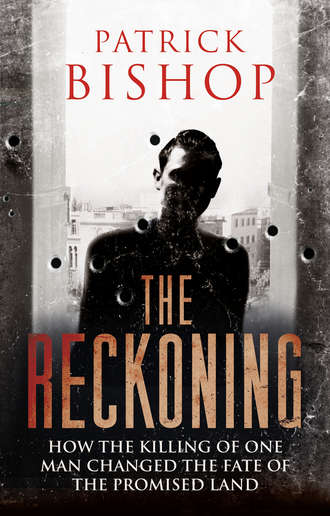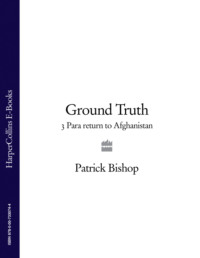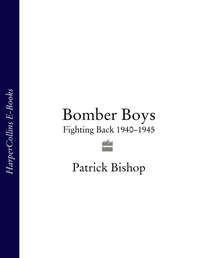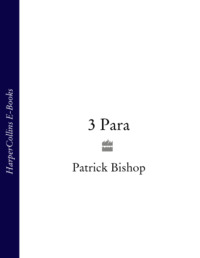
Полная версия
The Reckoning: How the Killing of One Man Changed the Fate of the Promised Land
Stern joined the Irgun early in 1932 and underwent a short junior officer’s course. His first contribution was to write a poem, ‘Anonymous Soldiers’, which subsequently became the Irgun anthem, with a melody composed by Roni Stern. Two of the verses sum up the essence:
We are soldiers without names or uniforms
Our companions are terror and death
We will serve in the ranks for the rest of our days
Only discharged with the last of our breath.
On days that are red with blood and atrocities
On black nights dark with despair
We’ll raise our flag in the towns and cities
On that flag ‘Protect and Conquer’ will appear.
At this stage these visions bore little resemblance to the activities of Stern and his comrades. He was mostly engaged in propaganda and political agitation, co-editing the Irgun magazine which preached unyielding resistance to Arab demands.
Stern was popular with his liberal-minded professors and his good manners and charm overcame misgivings they might have about his politics. In 1932, however, his activities brought him into conflict with the Hebrew University’s authorities. The chancellor, Judah Leon Magnes, an American-born liberal rabbi, intended to use the place to foster good relations between Jews and Arabs. When he appointed Norman Bentwich, the former Mandate attorney general who combined Zionism with sympathy for Arab aspirations, to the new Chair of International Peace, Stern helped to organize a protest. One demonstration had to be broken up by British troops at bayonet point. Even though Stern was not present he was suspended for several weeks.
Late in 1933 he left Palestine for the University of Florence, to study classical literature. His studies were interrupted when, the following spring, he was visited by the Irgun leader Avraham Tehomi who offered him the chance to do something significant for the cause.
He asked him to act as the Irgun’s agent, organizing the purchase of arms from Italian and Polish sources. Stern accepted eagerly. From now on, he would divide his time between Palestine and Europe. He roamed Poland, Romania and Italy posing either as a book salesman or a journalist, a correspondent for the Palnews weekly news magazine. His new work brought him into the Revisionist network in Europe, giving him great opportunities for building both a reputation and a following.
The movement was developing a distinct, radical political identity that put it increasingly at odds with the left. In 1935, Jabotinsky’s differences with Weizmann led him to pull his supporters out of the World Zionist Organization, and to set up the New Zionist Organization. This would now be the political face of Revisionism. It was supplemented by a militaristic youth organization, Betar, whose main strength was in Poland though branches had also been opened in Palestine.
Revisionism was, nonetheless, a movement rather than an ideological and organizational monolith, an ‘orchestra’, in Jabotinsky’s description, with himself as the conductor.18 He was the towering figure but his authority was far from dictatorial. Banned from Palestine, he had to watch events unfold there from Europe and America. He was nominally the Irgun’s ‘supreme commander’. He was unable, though, to exercise close control over policies and personalities.
Stern agreed with Jabotinsky that the aim of Zionism should be to flood Palestine with European immigrants who would establish a Jewish state inside broad borders that stretched across the Jordan river. They would achieve the goal by force of arms if necessary. But when he first caught sight of the great man in January 1935 in Kraków, at a Betar international assembly, he was not impressed. He wrote to Roni that Jabotinsky was ‘ageing. This is not the same person who could once rouse the masses to follow him.’19 Over the next few years his disenchantment would deepen as he grew frustrated with Jabotinsky’s flexible approach. Despite its treatment of him, Jabotinsky remained an admirer of the British Empire and imagined a future Israel as Britain’s ally in the region. For Stern, though the Arabs might be their immediate foe, the real enemy was the British who loomed behind them, blocking the road to a Jewish state. Over the next years he would turn against Jabotinsky, thus establishing a pattern of traumatic ruptures with colleagues that would last throughout his life.
Stern’s long periods abroad made it difficult to maintain his relationship with Roni. Nor did it help that he sent repeated, almost brutal, reminders to her that in the competition between love and duty the cause would always come first. The demands of his job would justify any disruption to their plans. She was nonetheless expected to be waiting, to minister to him humbly and lovingly when he decided that time allowed.
He finally proposed to her – eight years after they first met – during a visit to Tel Aviv in October 1935, but made it clear that the nature of the life he had chosen made it impossible for them to have children. For the time being, at least, she accepted his terms. ‘You are everything for me, beloved one,’ she wrote, ‘child and husband.’20 He immediately set off on a two-month trip to Athens, Bucharest and Warsaw, returning in time for the wedding, which was due to take place on 31 January 1936 at Ramat Gan, in the house of Roni’s cousin. When the ceremony was due to begin there was still no sign of Avraham. It was a Friday and the hour of Shabbat was approaching. The wedding canopy was just being dismantled when, according to Yair Stern, the guests ‘saw a herd of cows coming towards the place of the wedding … and out from the cows comes the bridegroom, with flowers that he collected in the fields for his bride’.21 The wedding photographs show a radiant Roni, wearing white and smiling at the camera, with her dapper husband standing proudly by her side.
The couple had three months together before Avraham departed once more for Poland. For the next three years he would shuttle back and forth between Europe and Palestine, boarding a ship at Haifa for the Romanian port of Constanta then proceeding by rail for Warsaw via Bucharest and Lvov. For much of the time in Warsaw he lived out of a suitcase, staying in cheap hotels and short-let apartments, spending his evenings in the Silver Rose and Europe cafés, arguing with friends and comrades over glasses of vodka and dishes of pickled herring. In the autumn of 1937 he was wafted into a higher social sphere. The charming, passionate young man caught the eye of a lawyer, Henryk Strassman, and his wife, Lily. Henryk was a senior official in the Polish Ministry of Justice, a lecturer in criminology at Warsaw University and a reserve officer in the Polish army. The couple were wealthy, well connected and Jewish. They had been assimilationists but the rise of Hitler and the mounting anti-Semitism of their fellow Poles converted them to Zionism. Lily soon fell under the spell of Stern who, she said, ‘enslaved my spirit with his simple and succinct talk’.22 She put her wealth and influence at his disposal. She opened the Yarden Club in Poznanska Street in central Warsaw to host Zionist gatherings. In addition, the Strassmans backed two new newspapers, Jerozolima Wyzwolona (Liberated Jerusalem) and the Yiddish-language Di Tat (The Deed).
They also introduced him to important figures in the Polish government. Stern’s direct manner inspired confidence and cut through red tape. ‘Matters that normally would require prolonged deliberations … were settled simply and without signatures,’ wrote Ada Amichal-Yevin. Some of the officials he came into contact with became friends, among them Witold Hulanicki, the art-loving Polish consul in Jerusalem who helped arrange passports for Betar youths bound for Palestine and overcome the obstacles that the British were always throwing up in an attempt to stem the flow of Jewish immigration.* This was a heady experience. A Jew from the provinces, not yet out of his twenties, was moving easily in the highest circles and by his skill and charm striking valuable deals with a government whose outlook was increasingly anti-Semitic. It reinforced his conviction that anything was possible and persuaded him that help for the great project could be found in the most unlikely-looking quarters. This belief would cause him great trouble later on.
There were plenty who could attest to the young Stern’s magnetism. Lily Strassman herself described her decision to follow Stern in almost mystical terms. ‘It’s difficult for me to explain that this was not a simple matter of persuasion,’ she said. ‘I wasn’t religious. But it was as if the finger of God had pointed him in the direction he had taken and to me to follow him.’23 Many of Stern’s acolytes were to use similar language in describing their dealings with him. Consciously or otherwise, their testimony has a scriptural ring to it, with them the disciples and Stern the Christ-like teacher. By now he was thinking and behaving as someone anointed for great things, a man who could not be expected to be constrained by the normal rules of discipline or behaviour. He conducted much of his business without reference to the Irgun command in Palestine, much less to Ze’ev Jabotinsky.
The Polish connection was essential to Jabotinsky’s vision. His grand plan was to arrange a mass exodus of 40,000 young Jewish males from Poland and elsewhere to Palestine, to form the core of a liberation army to wrest Palestine from the Arabs and challenge British rule. From late 1936, Betar members started training at clandestine military camps. Stern was closely involved in the process. Initially he teamed up with the man running the early courses, a Polish Jew named Avraham Amper. Then, through his contacts, he persuaded the Polish military to provide premises and instructors for three-month programmes. From the outset he seems to have regarded this as a personal project, one that would give him a power base independent of Jabotinsky, and he did his best to keep the details from him. By early 1939, the scheme had grown to the point where the Poles were providing a rigorous military education not only for local Jews but for visitors from Palestine. One young volunteer, Yaacov Levstein, remembered a twenty-four-hour rail trip from Constanta to Kraków, from where he went to a training base in the Tatra Mountains on the border with Czechoslovakia. The instructors were ‘Polish army officers, some of them veterans of Pilsudski’s legions, some former members of the pre-World War One Polish underground, and the rest Polish army career officers’.24 The instruction was divided into underground tactics and conventional war fighting. The underground training involved ‘terrorist bombing, conspiracy, secret communications … sabotage was taught on a scientific basis. Many hours were devoted to calculating the quantities of explosives needed for destroying targets.’
The lectures were accompanied by live exercises. ‘Every day we would go out to the woods … the vicinity roared with thunderous explosions, automatic fire and gun shots … we would go out at dawn on a long hike and come back at night, tired, frozen and dirty but joyous and hopeful.’
Avraham Stern would turn up during the course or at the passing-out parade and deliver speeches that moved not only the Jews but their Polish instructors. Levstein remembered him speaking ‘to us of his plan for national liberation and explained that if we did not act expeditiously the British would implement their plan of putting our country under Arab rule and reducing the Yishuv to a ghetto they could easily control’.
Yaacov Polani, another veteran of the course from Palestine who stayed on for a while afterwards as a Betar instructor in Poland, later told his British interrogators that Stern was believed to be using the training for his own ends. The programme was supposed to provide a professional military cadre which would remain in the ranks of the Betar and come under Jabotinsky’s overall control rather than that of the Irgun. Stern, however, was ‘busy organising what he called “the reservoir” … people who would get military training and on arrival in Palestine would join the [Irgun]’.25 This manoeuvre ‘did not find favour in the eyes of the Revisionist Party and a number of people were expelled from Betar for joining Stern’s activities’. When Betar leaders appealed to Jabotinsky to urge Stern to desist ‘he got certain promises from Stern but very vague ones’.
In effect, Stern was creating the nucleus of a band of followers who could later be relied upon to carry out his plans. Some stayed on in Poland until the German invasion, then, by one means or another, made their way to Palestine where they naturally gravitated to Stern. Among them was Avraham Amper, a quiet man who followed orders unquestioningly, and Yitzhak Tselnik, who was effectively Stern’s deputy at the time of his death.
Stern’s ambition also created problems with the Irgun leadership in Palestine. Following the split in the ranks in April 1937, when half the members had returned to the Haganah, his old friend David Raziel had emerged as the commander-in-chief of the hard-line rump. During his stays in Palestine, Stern took charge of propaganda and worked with Raziel to produce a statement of the new group’s principles, the first of which was that ‘the fate of the Jewish nation will be decided by Jewish armed force on the soil of the homeland’.
Stern was loquacious and sophisticated, Raziel was taciturn and dour. They were both, though, dedicated to violent action, as Raziel had demonstrated in his response to the Arab uprising. The attacks on Arabs in Jerusalem on 14 July 1937 that signalled the end of havlagah had been followed by many more bloody reprisals. In the summer of 1938 the British hanged a young Betar member, Shlomo Ben-Yosef, for his part in an unsuccessful ambush of a bus full of Arabs near Rosh Pinna in the north of the country. Raziel ordered a wave of bombings and shootings. They were directed not at Mandate forces but at Palestinian civilians. In one attack, mounted on 6 July 1938, an Irgun man disguised as an Arab porter carried milk cans into the Haifa souk. He left them in a quiet corner and disappeared. A few minutes later they exploded, spewing fire and shrapnel into the shoppers. Twenty-three Arabs were killed. A few weeks later a similar attack in the same place killed thirty-nine. Stern had no moral objection to such outrages. By now, though, he believed that the effort was misdirected, and that the violence should be aimed at the British.
He also opposed what he saw as Raziel’s deferential attitude towards Jabotinsky. In November 1938 Jabotinsky called a meeting in Paris with the aim of merging Betar with the Irgun. Raziel went along with the plan but Stern was bitterly critical of it. He avoided an outright confrontation with Jabotinsky but let his feelings be known to Raziel. Behind his back he took soundings of Irgun members in Palestine to gauge whether they were willing to break away from the partnership with the Revisionists and reject Jabotinsky’s authority altogether. Stern’s machinations on this occasion came to nothing. It was clear, though, that further confrontations with his comrades were inevitable and that sooner or later Stern would be going his own way.
* Hulanicki’s connection did him no good. He would be abducted and shot dead by Stern’s followers in February 1948.
FOUR
‘A Soul for a Soul and Blood for Blood’
In the spring of 1939 Roni Stern was living a dull life in Tel Aviv, giving piano lessons while waiting for her husband to make one of his intermittent appearances from Poland. From time to time her routine was brightened by an invitation to a party given by a man who lived around the corner from her apartment in Nevi’im Street in the centre of the city. Efraim Ilin was only twenty-seven years old but he was already one of Tel Aviv’s liveliest characters. He was employed as a tax clerk in the port. The job provided a cover of respectability as well as access to shipping traffic and he used it to build up a profitable business smuggling in illegal immigrants and weapons. Ilin’s sympathies were with the Irgun. His parties, though, were a social and political pot-pourri. In his flat in Chen Boulevard, many of the leading players in Palestine’s tumultuous affairs rubbed shoulders, drinking, gossiping and dancing to gramophone records of the latest tunes.
Among the guests were officers of the Criminal Investigation Department of the Palestine Police Force. After nearly three years the Arab revolt was losing momentum, worn down by the ruthless efficiency of the Mandate forces and the death or capture of key leaders. The CID was now spending an increasing amount of time investigating Jewish armed groups, and the Irgun in particular. An invitation from Efraim Ilin provided an opportunity to meet the Yishuv’s power brokers as well as those with links to the underground in convivial surroundings and to forge contacts that might provide valuable information and lead to useful alliances. Roni’s presence at the parties was encouraged by her husband and his Irgun associates for similar reasons.1
Among the regulars at Ilin’s soirées were three of the CID’s brightest officers. Arthur Giles was a child of the empire, born in Cyprus in 1899 to a family of soldiers and clergymen. He served in the Royal Navy in the First World War before joining the Egyptian Police Service where he acquired the honorific title of ‘Bey’, by which he was known to everyone. Giles Bey spoke Arabic, Greek and Turkish and was regarded as a brilliant policeman. In 1938 he decided his career would benefit from a change of scene and in March he was appointed head of the Palestine CID.
Dick Catling was a wiry, energetic twenty-seven-year-old. Like Geoffrey Morton he had joined the Palestine Police to escape the soul-destroying lack of opportunity in 1930s Britain. He came from a family of Suffolk farmers and butchers but decided to seek his fortune in London. ‘The only work I could find to do was in the City of London in a wholesale textile warehouse,’ he recalled. ‘I worked there for three and a half years and on most days at lunchtime I would wander down to the Pool of London and look at the ships, and say to myself, I really must get into one, and go away as soon as I can because this is all too depressing.’ One day, returning home to Suffolk, his train stopped at Ipswich. ‘There was another train on the other side of the platform and I looked out of my window and saw sitting in this other train a young man with whom I was at school. I hopped out and went across and said Parker, haven’t seen you since we were at school. He told me he was off to Palestine to join the police there, so I returned to my train and thought, well, if Parker can go to Palestine, surely I can.’2 Now, four years after arriving, he was one of Giles Bey’s brightest young detectives and relishing the challenges involved in penetrating the complicated and constantly changing world of Jewish political and military activism. It was ‘an extraordinarily fascinating battle of wits’, he said long afterwards. ‘We had to get up very early in the morning if we were going to come out on top.’3
Catling’s guide through the thickets of the Jewish political demi-monde was another East Anglian. Tom Wilkin was three years older than Catling and, like him, came from an ordinary home. His family lived in the Suffolk seaside town of Aldeburgh where they were publicans, grocers, drapers and shoemakers.4 He seems to have served in the Suffolk constabulary before joining the Palestine Police in 1931. Early in 1933 he went with a policeman friend to a ball at the Eden cinema, a Moorish-style venue in the centre of Tel Aviv, to celebrate the light-hearted Jewish festival of Purim when people wear fancy dress and make merry. Among the revellers was a blonde, pretty young woman wearing a long flowing dress and a black mask. Wilkin nonetheless recognized her as the same girl he had tried unsuccessfully to chat to at the Tarshish café overlooking the sea a few days earlier. Wilkin was a low-ranking inspector of police who lacked the polish of the young officers from old British regiments who populated Tel Aviv’s bars and hotels. He was slightly-built, had reddish hair and wore a rather unconvincing moustache. He was understandably nervous about making another approach to this sophisticated belle but his friend assured him that fate had clearly decreed that they should meet. They danced and talked. The young woman told him that she gave English lessons. Wilkin wanted to improve his Hebrew and they agreed to meet again. Thus was born an intriguing and unlikely love story that would endure until Wilkin’s violent death eleven years later.
The woman in the mask was Shoshana Borochov. She was the daughter of Dov Ber Borochov, a Russian-born Marxist-Zionist whose ideas helped shape the attitudes of the Yishuv’s left-wing establishment. Despite the high level of fraternization between Mandate officials and the Jews of Palestine, liaisons were frowned upon. Jewish parents were uneasy with their daughters consorting with Gentiles who seemed increasingly unsympathetic to their cause. The authorities, meanwhile, were concerned that soldiers and policemen would find that their loyalties were divided in the inevitable conflict between heart and duty. Shoshana and Tom defied the taboos despite family disapproval and official discouragement. They were not the only ones. Despite mounting tension between the Jews and the British, a surprising number of romances sprang up. Dick Catling had a Jewish girlfriend for a while, a Tel Aviv rabbi’s daughter whose sister went out with another policeman.
Wilkin’s Hebrew lessons were more than a ruse to win time with Shoshana. He was a natural linguist and was soon speaking the language fluently. He was intellectually curious and had a voracious interest in Jewish history and culture. Shoshana was from the Yishuv’s elite and introduced him to her circle. From these encounters Wilkin made his own friends, including businessmen like Ilin whom he met at a reception held by the mayor of Tel Aviv, Israel Rokach, and leading figures in the Jewish Agency and the Haganah. They were impressed by his good manners and genuine willingness to see their point of view, though when Ilin once challenged him over the ‘immorality’ of the stringent British restrictions on Jewish immigration he defended the Mandate line robustly.5 Wilkin was careful not to advertise the range and quality of his contacts. ‘He was a very close man … a secretive man if you like,’ Catling remembered. ‘He worked quietly and, more often than not, alone.’6
Wilkin’s chief, Giles Bey, was equally energetic in cultivating all the players in his domain, Arab and Jew, no matter where they were placed in the political spectrum. He would meet anyone and sit talking for hours, uncensoriously exploring their opinions in an apparent spirit of impartiality. It was a technique that his brighter subordinates – notably Catling – adopted and used to great effect.
The word soon spread that Giles Bey was a policeman to be trusted. This reputation attracted some surprising approaches, none more so than a communication he received at the end of 1938 from David Raziel. Raziel was in a delicate position. The Irgun were now engaged in a continuing campaign of reprisals against Arabs. At the same time, they were the main organizers of illegal immigration to Palestine, a traffic that was swelling weekly as the circumstances of Europe’s Jews grew ever more desperate. Both activities placed a burden on the Mandate’s law and order resources and attracted the unwelcome interest of the Palestine Police in the Irgun’s operations and members.
The CID played an extremely important role in the affairs of the Mandate. Its field of activities was broad and included monitoring all aspects of political life in Palestine. Its reports were crucial in determining the views of Sir Harold MacMichael and the analyses and recommendations he sent back to the Colonial Office. The department was very well informed about the machinations of established Jewish organizations. Much of the information came from friendly sources inside the Jewish Agency and the Vaad Leumi – the Jewish National Council, which represented all the main factions of the Yishuv. The authorities also engaged in systematic phone tapping from listening posts based at the Jerusalem headquarters and the CID’s four district headquarters. Yishuv organizations – and particularly the Haganah – were equally well informed about the workings of the Mandate. Jewish policemen and Jewish officials routinely passed on information to the Haganah’s intelligence service, the Shai. The Irgun’s equivalent section, Meshi, also had its moles. According to Yaacov Levstein, who became one of Stern’s most loyal lieutenants, ‘from its inception Meshi did not spare any efforts to infiltrating the CID and making use of its employees, who provided us with first-hand information on political affairs, lists of men about to be arrested, copies of various documents etc.’7










